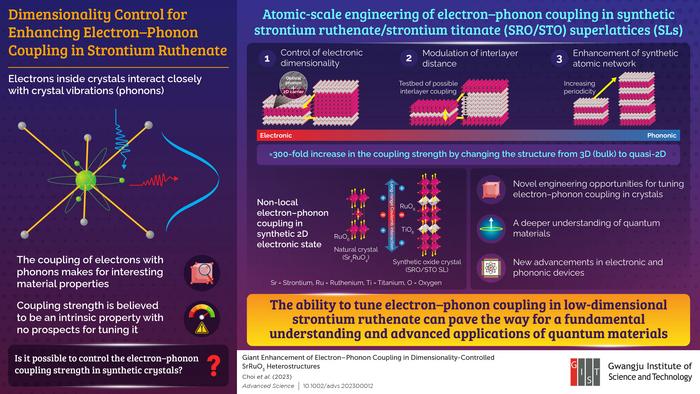Electrons inside crystals interact closely with phonons, defined as the discrete unit of crystal vibrations. The electron–phonon coupling strength is an important fundamental physical quantity in solid state physics, determining electrodynamic behaviors and correlated functionalities of a material. This, in turn, makes for interesting material properties with advanced applications. However, the coupling strength is typically considered an intrinsic material property without any provision for controlling it for desired applications.

Credit: Professor Jong Seok Lee from GIST, Korea
Electrons inside crystals interact closely with phonons, defined as the discrete unit of crystal vibrations. The electron–phonon coupling strength is an important fundamental physical quantity in solid state physics, determining electrodynamic behaviors and correlated functionalities of a material. This, in turn, makes for interesting material properties with advanced applications. However, the coupling strength is typically considered an intrinsic material property without any provision for controlling it for desired applications.
Against this backdrop, a group of researchers, led by Professor Jong Seok Lee of the Gwangju Institute of Science and Technology in Korea has now demonstrated the ability to tune this coupling and achieve a massive enhancement in its strength using synthetic heterostructures of transition metal oxides. The researchers have detailed their findings in a paper made available online on 13th April 2023 and published in Volume 10, Issue 16 of the Advanced Science journal on 2nd June 2023.
“Unfortunately, electron–phonon coupling is innately determined by the crystal structure of a solid, hence it was crucial to find a new method to control or enhance the coupling,” says Prof. Lee, explaining the motivation behind the present work.
In their study, the researchers demonstrated an atomic-scale engineering of the electron–phonon coupling strength in synthetic strontium ruthenate/strontium titanate (SRO/STO) superlattices (a periodic structure of layers of two materials). They achieved this remarkable feat by artificially heterostructuring the SRO/STO system. This entailed controlling the electronic dimensionality, modulating the interlayer distance, and increasing the periodicity of the synthetic atomic network.
Remarkably, a reduction in the dimensionality from 3D (bulk) to quasi-2D led to a 300-fold increase in the electron–phonon coupling strength. The researchers attributed this huge enhancement to the non-local nature of the coupling in synthetic SRO/STO superlattices, which becomes prominent in the 2D electronic state. In addition, they found that the electrons in the 2D SRO layers coupled to optical phonons (vibrations capable of absorbing or emitting light) as revealed by the temperature-dependent electron–phonon coupling measurements, which further contributed to the coupling enhancement.
This development paves the way for novel engineering opportunities for tuning electron–phonon coupling strength in crystals. In addition, it facilitates a deeper understanding of quantum materials. “The electron–phonon coupling is closely related not only to the performance of thermoelectric devices but also the energy harvesting efficiency of solar cells. Currently, researchers are struggling to solve the overheating issue in nano-scale devices. This problem limits the performance of such devices. The present work can contribute to solving the overheating issue, resulting in an improved performance of nano-scale devices,” speculates an optimistic Prof. Lee.
Overall, these findings provide new insights into the tuning knobs available in synthetic crystals for controlling the electron–phonon coupling strength, useful not only for advancing technology but also for a deeper understanding of quantum phenomena like strongly coupled charge and lattice dynamics in quantum materials.
***
Reference
DOI: https://doi.org/10.1002/advs.202300012
About the Gwangju Institute of Science and Technology (GIST)
The Gwangju Institute of Science and Technology (GIST) was founded in 1993 by the Korean government as a research-oriented graduate school to help ensure Korea’s continued economic growth and prosperity by developing advanced science and technology with an emphasis on collaboration with the international community. Since that time, GIST has pioneered a highly regarded undergraduate science curriculum in 2010 that has become a model for other science universities in Korea. To learn more about GIST and its exciting opportunities for researchers and students alike, please visit: http://www.gist.ac.kr/.
About the author
Jong Seok Lee is a professor at the Department of Physics and Photon Science at Gwangju Institute of Science and Technology (GIST), Korea. In 2004, he received a PhD degree in physics from Seoul National University in Korea. Before coming to GIST, he was affiliated with the University of Tokyo in Japan and the Infrared Beamline at BESSY in Germany. His group investigates various novel phenomena in solid state materials, such as electric/magnetic phase transitions, magnetoelectricity, ultrafast quasi-particle dynamics, etc. by exploiting spatio–temporal linear and nonlinear spectroscopic techniques.
Journal
Advanced Science
DOI
10.1002/advs.202300012
Method of Research
Experimental study
Subject of Research
Not applicable
Article Title
Giant Enhancement of Electron–Phonon Coupling in Dimensionality-Controlled SrRuO3 Heterostructures
Article Publication Date
2-Jun-2023
COI Statement
The authors declare no conflict of interest



